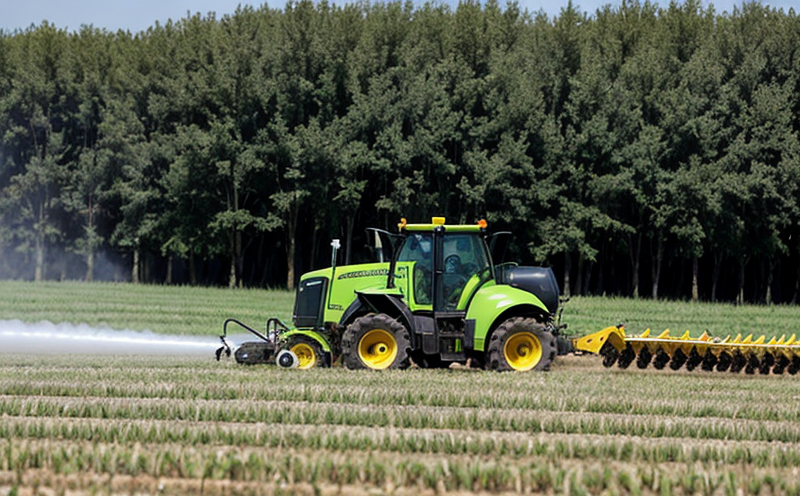Pyraclostrobin Residue Testing in Crops Validation Method Development Test
The demand for safer and more sustainable agricultural practices has led to an increased focus on the residue levels of pesticides, such as pyraclostrobin, within crops. Pyraclostrobin is a fungicide used primarily in agriculture to control fungal diseases. Ensuring that residues remain below specified limits is crucial to maintaining food safety standards.
The testing and validation of methods for detecting pyraclostrobin residues are critical components of ensuring compliance with international guidelines like ISO, ASTM, EN, and IEC. The primary goal of this service is not only to identify the presence of pyraclostrobin but also to develop robust, accurate, and reliable analytical methods that can be used in routine quality control processes.
Our laboratory employs state-of-the-art equipment and follows rigorous protocols to ensure precision and accuracy in our testing. The method validation process includes several key steps: selecting the appropriate analytical technique, optimizing the method parameters, validating the linearity of the calibration curve, assessing recovery rates, determining limits of detection (LOD), quantification limits (LOQ), and ensuring method robustness.
During specimen preparation, samples are typically extracted using solvent-based methods such as QuEChERS (Quick, Easy, Cheap, Effective, Rugged, Safe) or similar techniques. These extracts undergo thorough purification steps before being analyzed via HPLC-MS/MS for precise quantification of pyraclostrobin residues.
The accuracy and reliability of the method are validated against certified reference materials to ensure consistent results across different batches and laboratories. This service is particularly valuable for quality managers, compliance officers, R&D engineers, and procurement teams who need assurance that their processes meet regulatory requirements while maintaining product safety.
Our team works closely with clients to understand specific needs and challenges related to pyraclostrobin residue testing in crops. By providing tailored solutions, we help ensure that our clients are compliant with relevant international standards and can confidently market their products in a global marketplace.
The method validation process is an ongoing effort that involves continuous improvement based on feedback from clients and advancements in analytical technology. This ensures that the methods remain up-to-date and effective over time.
Scope and Methodology
The scope of this service includes developing validated methods for detecting pyraclostrobin residues in various crops. This involves selecting appropriate analytical techniques, optimizing method parameters, validating linearity, assessing recovery rates, determining LODs, LOQs, and ensuring robustness.
For the method development process, we use HPLC-MS/MS as our primary analytical tool due to its high sensitivity and selectivity. The extraction of samples is typically done using QuEChERS or similar techniques followed by thorough purification steps before analysis.
The validation criteria are based on international standards such as ISO 17025, ASTM E691, EN 14184-3, and IEC TS 62785. These standards ensure that the methods meet stringent quality control requirements and can be relied upon for accurate results.
During specimen preparation, samples are extracted using solvent-based methods before undergoing purification to remove interferences. The purified extracts are then analyzed by HPLC-MS/MS to measure pyraclostrobin residues accurately.
The validation process includes several key steps:
- Selecting appropriate analytical techniques
- Optimizing method parameters
- Validating linearity of the calibration curve
- Evaluating recovery rates
- Determining limits of detection (LOD)
- Determining quantification limits (LOQ)
- Ensuring method robustness
These steps ensure that the methods are reliable, accurate, and repeatable for routine quality control purposes.
Benefits
The benefits of our pyraclostrobin residue testing in crops validation service extend beyond mere compliance with regulations. By providing precise measurements and validated methods, we help ensure the safety of food products while supporting sustainable agricultural practices.
Our clients benefit from:
- Rigorous method development based on international standards
- Precise measurement capabilities that enhance product quality
- In-depth understanding of pyraclostrobin residues in crops
- Comprehensive support for regulatory compliance and audits
- Access to advanced analytical instrumentation tailored to specific needs
- Customized solutions addressing unique challenges faced by different sectors
- Continuous improvement through client feedback and technological advancements
By partnering with us, clients can focus on innovation while we handle the complexities of method validation. This allows them to stay ahead in a competitive market where safety and sustainability are paramount.
Industry Applications
The application of pyraclostrobin residue testing in crops validation methods is wide-ranging, particularly within agriculture and forestry sectors. These tests play a critical role in ensuring the efficacy and safety of fungicides like pyraclostrobin while also supporting sustainable farming practices.
Agricultural industries benefit from our services by:
- Ensuring compliance with international standards
- Minimizing risks associated with pesticide residues
- Enhancing the reputation of their brands through transparent and safe products
- Supporting research aimed at improving crop health without compromising food safety
- Facilitating trade between countries by meeting stringent import/export regulations
- Providing data to support claims about product purity and efficacy
- Offering insights into the behavior of pyraclostrobin in different crops under various conditions
In forestry, this service supports initiatives focused on maintaining healthy trees by identifying potential issues early. It also helps in understanding how pyraclostrobin behaves in wood and bark, contributing to more informed decision-making regarding its use.
Our expertise extends beyond just testing; we offer valuable insights that can guide strategic decisions for sustainable practices within these industries.





